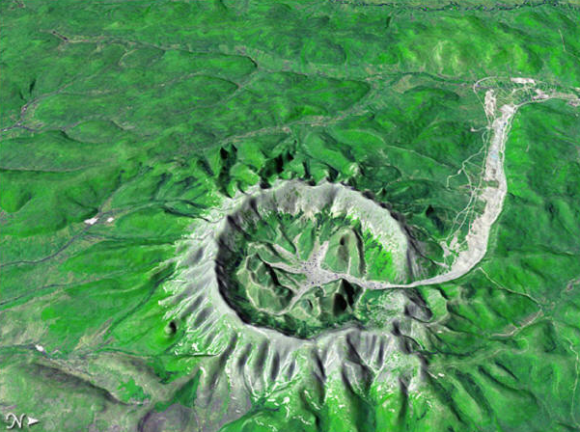The Electric Universe
This geologic anomaly is Kondyor Massif.
There is very little information about this mysterious “circle of rock” other than that most of the world’s surface titanium is found there…and electrical activity is present —
From Thunderbolts.info,
Geologists say it is an intrusion of igneous, or volcanic, rock that pushed up through overlying layers of sediment. Electric arcs provide a better explanation.
“A six-kilometer-wide circle of rock contrasts with the surrounding topography in Northern Siberia. It looks like a crater formed by the impact of a stone from space or an extinct volcano, but neither explanation seems to fit more detailed observations.
The Advanced Spaceborne Thermal Emission and Reflection Radiometer (ASTER) on NASA’s Terra satellite observed Kondyor Massif on June 10, 2006. A three-dimensional image of the formation was created in order to provide an indication of its proportions. There is little vegetation within the ring of rock as the ASTER image reveals. A river flows out of the massif on the north side, fed by rainwater collecting within the uplifted rim.
An interesting feature of the river is that it appears to cut through the rim of the massif at one point, as if it adopted a channel that was present before the river began to flow. The geological term for such an anomaly is “superimposed topography.” In other words, the river and its bed seem to be inserted into the terrain, rather than developing with it.
Kondyor Massif is unique not just because of its unusual structure, but for the mineral veins within it: gold, silver, and platinum are mined there by the Russian government. Previous Picture of the Day articles about the Siberian Traps and Popigai Crater noted that northern Russia possesses rich diamond, copper, nickel, and coal deposits. Popigai is one of the world’s most profitable diamond resources and includes one of the most concentrated examples of nickel-bearing ore in the world.
Kondyor is not an impact crater, per se, because the hallmarks of electrical activity are present…”
For the rest, click here.
Share

